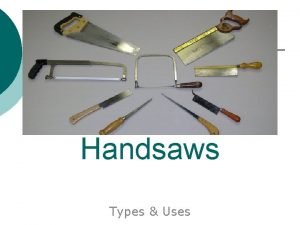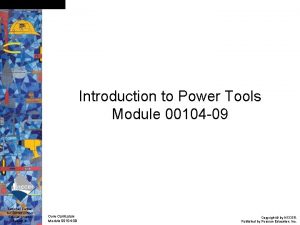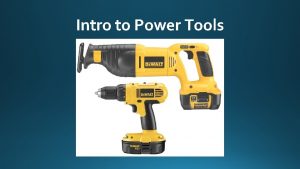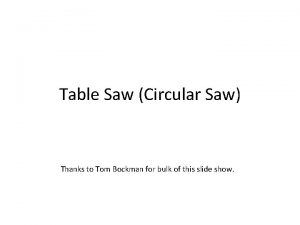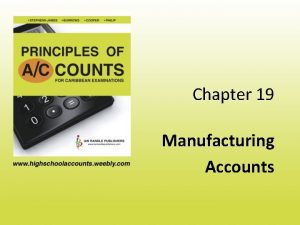Manufacturing Technology Power Tools Circular Saw Circular Saw













- Slides: 13

Manufacturing Technology Power Tools: Circular Saw

Circular Saw Safety

Why are circular saws a safety concern?

Accident History o o In a study of 1000 accidents of woodworking machines, accidents at circular saw benches accounted for 35% of the total. Most resulting in the amputation of fingers 83% of the accidents occurred cross-cutting or ripping In most cases the saw guard was either missing or not properly adjusted

Circular Saw Safety Hazards o Machine hazards n n n o o Point of operation Rotary and reciprocating movements In-running nip points (pinch points) Kickbacks Flying chips, material Tool projection Electrical hazards

What should you do before start cutting with a circular saw? o o o Wear safety glasses or a face shield. Wear an approved respirator or dust mask when exposed to harmful or nuisance dusts. Use appropriate hearing protection equipment in noisy areas. Check the retracting lower blade guard to make certain it works freely. Ensure that the blade that you have selected is sharp enough to do the job. Sharp blades work better and are safer.

What should you do before start cutting with a circular saw? o o Check the saw for proper blade rotation. Set the depth of the blade, while the saw is unplugged, and lock it at a depth so that the lowest tooth does not extend more than about 0. 3 cm or 1/8" beneath the wood. Keep all cords clear of cutting area. Circular saws are designed for righthand operation; left-handed operation will demand more care to operate safely.

What should you do to work safely with a circular saw? o o Check the retracting lower blade guard frequently to make certain it works freely. It should enclose the teeth as completely as possible, and cover the unused portion of the blade when cutting. Check that the retracting lower blade guard has returned to its starting position before laying down the saw.

What should you do to work safely with a circular saw? o o Use two hands to operate saws - one on a trigger switch and the other on a front knob handle. Keep motor free from accumulation of dust and chips. Select the correct blade for stock being cut and allow it to cut steadily. Do not force it. Secure stock being cut to avoid movement.

What should you avoid when cutting with a circular saw? o o o Do not hold or force the retracting lower guard in the open position. Do not place hand under the shoe or guard of the saw. Do not over tighten the blade-locking nut. Do not twist the saw to change, cut or check alignment. Do not use a saw that vibrates or appears unsafe in any way. Do not force the saw during cutting.

What should you avoid when cutting with a circular saw? o o Do not cut materials without first checking for obstructions or other objects such as nails and screws. Do not carry the saw with a finger on the trigger switch. Do not overreach. Keep proper footing and balance. Do not rip stock without using a wedge or guide clamped or nailed to the stock.

Applicable OSHA Regulations o Section 1926. 304: Woodworking Tools n (d) Guarding. All portable, power-driven shall be equipped with guards above and below the base plate or shoe…When the tool is withdrawn from the work, the guard should automatically and instantly return to the covering position.

Applicable OSHA Regulations o Section 1926. 302 - Power Operated Hand Tools (a) Electric power-operated tools (2)The use of electric cords for hoisting or lowering tools shall not be permitted.
 Manufacturing cost vs non manufacturing cost
Manufacturing cost vs non manufacturing cost Process vs job costing
Process vs job costing Cost concept and classification
Cost concept and classification Manufacturing cost vs non manufacturing cost
Manufacturing cost vs non manufacturing cost Additive manufacturing steps
Additive manufacturing steps Ripsaw vs crosscut saw
Ripsaw vs crosscut saw Triangle of power
Triangle of power Shallow trench isolation
Shallow trench isolation Tissue manufacturing technology
Tissue manufacturing technology Group technology and cellular manufacturing
Group technology and cellular manufacturing Semiconductor wafer
Semiconductor wafer 4 classification of hand tools
4 classification of hand tools Module 4 power tools
Module 4 power tools A power miter saw combines a miter box with a
A power miter saw combines a miter box with a





